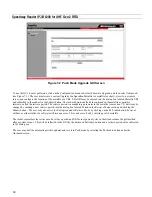
Speedway Reader IPJ-R1000 for UHF Gen 2 RFID
27
Image Versioning Scheme
Each partition has a four-part version number associated with it. In the upgrade configuration file (see section 7.3), the version
number is represented by a string consisting of four fields separated by ‘.’ (dot):
ddd.ddd.ddd.ddd
where each field is a decimal number ranging from 0 to 255. The left-most field is the most significant part of the version
number with sub-versions provided to the right. For the purpose of upgrades, when two version numbers are compared, the one
with the largest leftmost number is considered a higher version and therefore a newer image. For example, if two versions
being compared are 2.3.4.9 and 2.4.4.1, 2.4.4.1 is considered newer because the second number from the left is larger (in this
case 4 versus 3). Other than this comparison, the upgrade mechanism assumes no additional meaning for the version string.
7.1. Upgrade
Methods
Speedway provides two methods to support software upgrade: push and pull. Push mode is a manual technique to perform an
upgrade on an individual reader. Pull mode is an upgrade method that allows simultaneous upgrade of multiple readers
through a single Upgrade Configuration file called a metafile. The default configuration of the reader is “push” mode.
In push mode, the user can trigger a one-time upgrade of the Speedway image. When triggering the upgrade, the user must
specify the location of the Upgrade Image File as a URI. The upgrade will be performed if any of the partitions within the new
image are different than those contained in the primary image. Once the download and programming have completed, the
reader will remain in push mode and will perform no further upgrades until a new client request is issued. In push mode, the
reader will not reboot automatically to activate the new image. The user must issue a reboot command (see section 8.3.1) to
complete the activation.
In pull mode, the user creates a custom Upgrade Configuration Metafile (or metafile for short). This metafile is stored on a
remote server. The user configures the location of the metafile as a URI. The reader downloads the data contained in the
metafile at periodic intervals (called the retrieve period) and uses that data to make automatic upgrade decisions. The reader
remembers the retrieve mode, retrieve period, and URI across power-cycles so that it can resume the pull method after a system
reboot. Typically, when the reader retrieves the metafile at a scheduled time (or when it reboots), it will find that no upgrade is
needed because, in the absence of any change in the metafile on the server, the image version the reader is running is the same
as that specified in the metafile.
7.2. Preparing the Upgrade Image
The path and permission of the image file on the server should be set properly to allow file retrieval via the method as specified
by the
upgrade-file-uri
field of the metafile or by the image URI.
7.3. The Upgrade Configuration Metafile
The Upgrade Configuration metafile is at the core of the pull upgrade mechanism. The user prepares this file based on upgrade
requirements and saves it on a file server accessible from the reader. The file contains instructions to the Speedway reader as to
how to perform the upgrade as a list of text-based entries. Each data entry consists of a single line data field and may be
qualified with one or more parameters separated with a semi-colon. Table 7-1 lists the data entries in the metafile. All data
fields and parameters are mandatory unless marked as optional. The format of a data entry is as follows:
field-name:field-value{;parameter-name=parameter-value} <EOL>
Important
The metafile must not contain any Unicode characters
.
















































